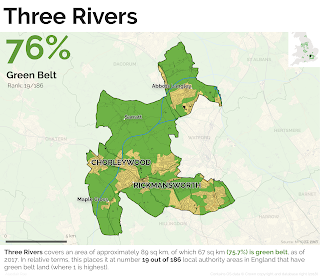Where is the green belt? Where are the green belts? How much of my area is green belt land? These are excellent questions, but it's not always super easy to find the answer, and that's why I originally began investigating this topic back in 2012. This then eventually led to me producing maps for each English local authority that had green belt land in it, thanks to an idea suggested to me by geo legend Prof Bob Barr. Since I last did this in 2018 the number of local authorities in England has changed and there is a more recent green belt dataset, so I'm returning now with version 5 of my English Green Belt Atlas. Currently, 12.4% of land in England is designated as green belt, across 180 local authorities, but it varies a lot between places, as you can see below. I have made one map for each of the 180 areas, listed alphabetically (they are really high resolution images). How big is 12.4% of England? It's 16,140 square kilometres or 6,232 square miles. This is just a little bigger than the South East region or Yorkshire and the Humber, and about 80% the size of Wales, just to give a sense of scale. From 2020 to 2021 there was a 0.1% decrease in the amount of green belt land.
 |
| I did my best with the labelling |
 |
| I've tried to keep the maps fairly simple |
 |
| An example of a very split local authority area (rail line) |
 |
| This area has the highest % green belt land in England |
 |
| Not an awful lot of green belt land here |
Okay, so you get the idea with the maps - I've shown rail lines (dark), railways stations (little circle dots), places (square dots, different sizes), major roads (orange), buildings (dark), water, green space (light blue) and green belt land in a darker green. The little dot in the bottom right inset map shows you where a local authority is, just in case any are not familiar. I've automated the labelling but it's not 100% perfect, but I can't spend any more time on it. Want to use one of these maps, or all of them? Be my guest.
Here's a few more that I found interesting. You can find the full set, listed alphabetically,
right here.















































